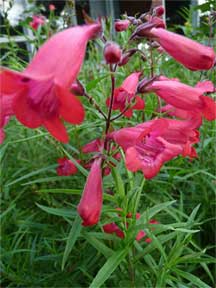Penstemon, pronounced pen-stem-on belongs to the same family of plants as the familiar snapdragon, and many of the species produce spikes of bloom with a superficial resemblance to that flower. Colors range the spectrum with most species falling into the blue-purple-red range. There are a few white and yellow forms as well. The colors appear in an amazing range of shades and tints. Usually, the corolla (petals) will show several graduations of the basic color, with the throat frequently a contrasting color.
The throats of many kinds are marked with darker colored “guide lines” that run from the lower tip of the corolla back toward the nectary, located in the tube of the flower. These guide lines add interest to the individual flowers. It is believed that they have a useful function in guiding the pollinating insects past stamens and pistil and so insure fertilization. (The old story of the bees and flowers again!)

Variety of Forms
Penstemons come in all sizes and forms, ranging from low growing shrubbies like rupicola, menzesii and davidsonii, ideal for rock garden or ground cover, to the upright shrubby forms like fruticosa, barrettiae and montanus, that make mounds a foot or more tall. Still other pents are herbaceous and not at all woody. Some of these die back to the ground line in the fall, but many of the herbaceous kinds make neat rosettes that stay green all winter and give color to the otherwise drab garden. Among the herbaceous kinds are pygmies that never exceed a few inches in height to giants that may exceed six feet.
As a class, pents make their great show between the end of the spring bulbs and the time when summer flowers take over. They fill an otherwise rather colorless period with a blaze of blue and red spikes that are showy in the border and excellent for cutting.
There are kinds that will do well in almost any garden except the bog garden, or a garden in deep shade. Such species as canescms, digitalis, hirsutus perform well from coast to coast with minimum effort on the gardener’s part. This list of easy pents will increase as new forms are brought into cultivation, and as the efforts of breeders, professional and amateur, produce new hybrid forms better adapted to garden use.
For the garden with full sun and good drainage, such species as alpinus, nitidus, strictus and unilatemlis native to the ranges and foothills of the Rocky Mountains bring the sky blues, deep blues and purples so rare in garden flowers. Those like barbatux, murmyanus and ‘Flathead Lake’ blaze in flaming scarlets or soften to pinks and corals.
First Spectacular of the Penstemons
One of the first spectacular of the penstemons as well as one of the easiest to grow is the mystery plant ‘Flathead Lake’ for which the scientific name P. Johnsoniae was proposed. This was introduced to horticulture by Anna Johnson of Butte, Montana. She obtained it from a collector who claimed to have found it growing wild near Flathead Lake, Montana. This penstemon is everblooming, when happy, and comes in colors that range from brilliant scarlet to pinks and corals. Plantsmen are pretty well agreed that it must be a natural hybrid between the scarlet P. barbatus and some unidentified species. It is good!
Regardless of its parentage, this is destined to become one of the great penstemons of all time. With its sturdy spikes of pink, rose, coral or scarlet, it is an ornamental, par excellence. Even more important, it crosses readily with many species, thus breaking the barriers of genetic isolation that have hampered attempts at hybridizing in the past.
In the years it has been available, it has been crossed with many species combining the blues with reds in a series of brilliantly purple hybrids. As seeds of these new hybrids are grown, new color combinations and plant forms appear. These hybrids will have the greater vigor and wider adaptation given by hybridity.
The Plains Prosper
Gardens of the Great Plains and desert areas stand to profit most from the penstemon adventure, since these plants have their center of development in this area. The hardiness and vigor that have enabled the genus to extend across plains, mountains, and deserts from Alaska to Central America and from the Atlantic to the Pacific are being combined in the coming hybrids.
Unlike some of our flowers from foreign climates, barely able to survive here with tender care, the penstemon is a truly North American plant, tailored to our gardens. The penstemons will be happy where wind, heat, cold and drought are the usual order of things.
If this admittedly glowing, but nevertheless conservative, description of the penstemon tribe makes you want to grow them, there is no better way to start than to join the American Penstemon Society.
